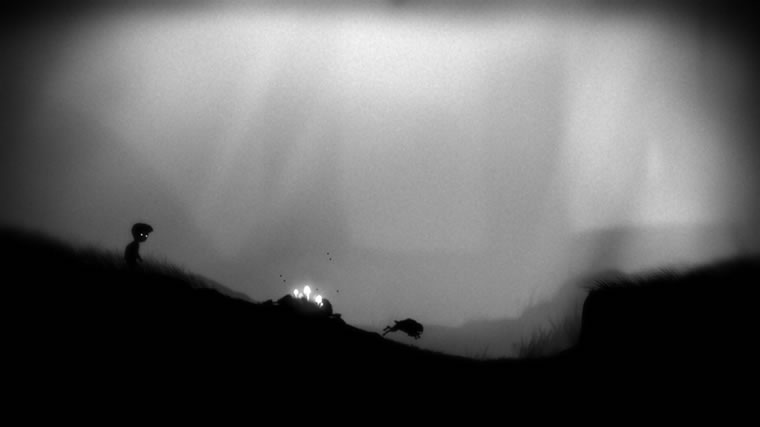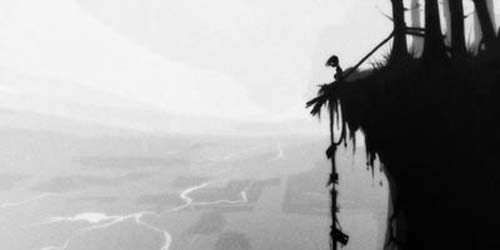Limbo is minimalist game design in its purest form. Aside from the main menu, there are absolutely no words through the entire story. No spoken dialogue, no text, nothing. There is no tutorial. You are thrown straight into the plot.
You're a small boy unconscious in a forest. The visual style of Limbo is immediately striking--it's entirely in grayscale, with characters all in silhouette. And the music is minimal. No score, no sweeping theme song. Ambient sounds are the only tunes accompanying the boy, supplemented by single orchestral notes at particularly poignant moments.
The boy, who is never given a name, doesn't wake up until the player presses A. But the game doesn't tell the player to do this; they must figure this out on their own. Once he's awake, control is simple. The control stick moves the boy, the A button makes him jump, and the B button lets him push and pull objects in the environment. That's it. Even the boy's jump ability is fairly modest compared to most other 2D platformers.
This isn't an empowered protagonist like we're used to seeing in this medium. It's just a boy. We're left to come to our own conclusions about anything more than that, because there is absolutely no exposition or backstory. SLIGHT SPOILER ALERT We learn about halfway through the game that he's searching for a girl. Perhaps it's his sister, but this is never expanded upon. Again, we're left to come to our own conclusions. END SLIGHT SPOILERS
Limbo is essentially a puzzle-platformer. The boy must manipulate the environment to get through to the next area. But why he's doing this is anyone's guess. And I like it that way.
 As the boy travels through this forest, it seems everything wants to kill him. A tribe of slightly older boys sets traps for him, and a Shelob-like giant spider wants to consume him. We see the bodies of other children hanging from gallows in the background. There's a very Lord of the Flies feel to it all.
As the boy travels through this forest, it seems everything wants to kill him. A tribe of slightly older boys sets traps for him, and a Shelob-like giant spider wants to consume him. We see the bodies of other children hanging from gallows in the background. There's a very Lord of the Flies feel to it all.Death is all around the boy. In a particularly disturbing sequence, the boy must conquer the spider chasing him by amputating its legs himself. Once the spider has been fully de-legged, the boy must roll its torso into a spike pit and use it as footing to jump off.
Another factor in all this violence is the realization that this boy cannot swim. Any time he goes underwater, he drowns to death. In one sequence, the boy must use the floating corpses of other children to get across a pond. Death follows the boy everywhere--rotting carcasses of animals are pervasive throughout the forest, and insects follow him everywhere. This grisly subject matter might be too much to handle, but the silhouette art style makes it palatable.
Considering how two-tone the visuals are, his deaths are jarringly graphic. The deaths get increasingly gruesome as the game goes on. Being a puzzle-platformer, the player will die dozens of times in one playthrough. But the boy always reappears quickly next to the trap that killed him, so players can try again. Through the sheer volume of deaths, players get almost desensitized to the violence incurred on this small child.
SPOILER ALERT
There is no "final boss," and I commend Playdead for eschewing this game industry trope. Instead, near the end of a puzzle, the boy shatters through glass and dies. For real. He doesn't respawn to where he can try again. He actually dies.
But then he wakes up again, much like in the beginning of the game. He's in a forest, and he finds the girl he's been searching for. She's near a ladder, sitting down. She looks up. And then the credits roll.
After the credits, we come back to the game's main menu screen. We make the realization that the ending of the game has been staring us in the face ever since we began: the main menu screen shows the ending of Limbo. It's the same forest as the ending scene, with the same wooden ladder. But it's rotting. And instead of the boy and girl, we see two lumps on the ground with insects buzzing around them.
This abrupt ending was very polarizing for players. But to me, it fits. In an experience where he has died countless times in various super-violent manners, this is closure for the boy. He can finally rest. And perhaps "true death" was the only way for him to find this girl. He's finally out of limbo, and can have his eternal sleep.
END SPOILERS
But that's just my interpretation of the ending. It's up to you to decide what you think. And that's the beauty of ambiguous endings, something far too scarce in the gaming medium. But it's not the only game like this...
As far as "arty 2D platformers" go, Limbo is often mentioned in the same breath as Jonathan Blow's Braid. But though Braid also features no tutorial and an ambiguous story, Limbo's minimalism puts it firmly on top for me. Braid uses a beautiful orchestral soundtrack and hand-drawn, exquisite visuals. But it reeks of pretension, exacerbated by the endless walls of text between levels presented to give the story meaning. In addition, Jonathan Blow has publicly spoken at length on numerous occasions about the themes behind his game. Playdead, on the other hand, has intentionally left the meaning of their game up to the players, and hasn't said anything about the themes of Limbo since it was released.
Braid is a fantastic game, but it relies on overuse of another medium (literature) to deepen the experience. Limbo is something that could really only be accomplished in gaming.




No comments:
Post a Comment